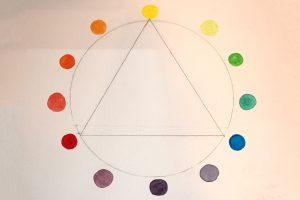Recently, I started taking a watercolor painting class at my local recreation center from a very prominent artist who specializes in watercolors. Even though I have a lot of knowledge in other art mediums, I literally know nothing about watercolor painting. I decided to start my watercolor adventure at the beginning level.
I went with an open mind and tried to erase everything I had learned about art over the years in my formal and informal training. I wanted to be a blank slate to try to absorb any new knowledge and be receptive to a new experience.
I reintroduced myself to the essential skills and fundamentals of art. I have gained a vast amount of new insight into a very challenging and frustrating medium; watercolor painting.

A refresher course in color theory was very helpful. Water and pigment (paint) mixing takes a lot of practice to attain that delicate balance of transparency.
By trial and error, it all begins with one brush stroke on the paper. It is quite intimidating. This is a unforgiving medium with little room to forgive mistakes.
There are two methods of watercolor painting:
- Wet on Wet
- Wet on Dry
Watercolor painting works in a 3 step process:
- Value
- Blocking
- Detail
Determining the local color (the lightest value) and blocking in that color in your painting.
Then working from light to shade (value); less intense to more intense to add dimension and depth in a painting.
Lastly, the details are added into the painting to complete the process.
Special effects can be added before, during, or after you are working on a painting. There are many types of special effect techniques, such as masking, spattering, sponging, and so on to give you that bit of drama in your painting.

A spectrum of colors can be created by mixing complimentary colors just like any other medium, but it is especially important to create value and shape to an object. It is crucial to understand how to build value in a watercolor painting with a process that is done in stages called layering. The layering of color values create light and shadow.
This was an excellent project for determining values. This exercise required that you use only burnt sienna and ultramarine blue to create the values in the below painting. Determining the values of the exercise, we created a value bar which formed the light and shadow areas of the painting.


Values are everywhere in a painting.
There are four aspects of light and shadow.
- Highlights
- Cast Shadows
- Reflected Light
- Crest Shadow
This was my first project working with light and shadow (values).

Watercolor painting is a whole new cup of tea. It is much harder to comprehend and master.
In oil painting, you can mix colors and create immediate gratification by building colors upon colors. You can go light on dark or dark to light quickly. You can easily cover up any mistakes.
In watercolor painting, it takes a lot of patience. It may take ripping up your paper and starting over again to achieve that masterpiece you are creating. Don’t get discouraged! Time is not wasted! Watercolor painting is truly a learning experience!
Currently, I am in the immediate watercolor class. Take a look at a few of my recent projects. You can see some improvement as I hone my watercolor painting skills.


Always,
Cheryl
Hint: If you are looking for a great watercolor tube paint, may I suggest investing in a professional grade watercolor tube paint. These tubes are a bit more costly in the long run, but definitely worth the extra bucks especially if you are looking for quality in your work. There is a distinct difference between student grade and professional grade. Student grade tends to be more grainy and the quality isn’t that great.
Brushes are costly, but if you are planning on sticking with this medium, you may want to invest from the start with natural sable brushes. Sable brushes are worth the money. This doesn’t mean that you won’t need other kinds of brushes along the way. I have many other types of synthetic brushes as well. These other types of brushes serve many other purposes. However to lay down a smooth stroke, natural brushes are definitely better.
Currently, I am using Winsor & Newton Professional Water Colour tubes for my artwork. I also love the Winsor & Newton Professional Water Colour Sable brushes.
